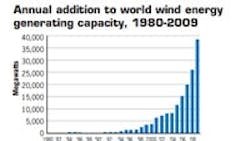On the Energy Front
TURBINES CAPTURE MORE AND MORE WIND
Global wind power capacity increased by 38,343 MW to a total of 158,505 MW in 2009, according to the Worldwatch Institute, Washington, D.C. Despite a widespread economic recession, new wind power capacity grew more than 31%, the highest rate in the last eight years. China passed the U.S. to become the world's largest wind turbine market. Worldwide, wind power contributed 340 trillion kilowatt-hours, or 2%, to global electricity consumption.
WHERE THE POWER GOES IN SERVERS
On average within an individual server, processors and memory consume the most amount of power, says CPU maker Intel. Next comes power supply efficiency loss. Disk drive power only becomes significant in servers with several disk drives. Processor power consumption varies greatly depending on the type of server processor. Multi-core CPUs can consume anywhere 45 to 200 W per CPU. Multi-core processors are much more power efficient than previous generations. Servers using the recent Quadcore Intel Xeon processors can deliver 1.8 teraflops at peak performance using less than 10 kW. Pentium processors in 1998 would have consumed about 800 kW delivering the same performance.
ENERGY DIET FOR COMMON FOODS
The Industry Council for Packaging and the Environment in the U.K. recently compiled data outlining the material and energy requirements along the food supply chain. The main source of information is the U.K. government's National Food Survey, but the figures are likely to be similar for food consumption in the U.S.
WHERE DOD FUEL DOLLARS GO
A paper by the Rocky Mountain Institute in Boulder, Colo. illustrates the cost of fuel for the Dept. of Defense compared to that of the civilian sector in 2005. The entire U.S. consumed 7.54 billion barrels of oil that year, worth $596 billion, and accounted for about a quarter of world oil use. The Institute also points out that DoD's fuel cost was about $12.5 billion in 2006, but that figure is a modest fraction of true fully-burdened delivered fuel cost. The added delivery costs are mainly for the 9% of Air Force fule delivered aerially for $49/gal and for forward fuel to the Army in Iraq.
